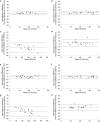Inter-vendor reproducibility of left and right ventricular cardiovascular magnetic resonance myocardial feature-tracking
- PMID: 29538467
- PMCID: PMC5851552
- DOI: 10.1371/journal.pone.0193746
Inter-vendor reproducibility of left and right ventricular cardiovascular magnetic resonance myocardial feature-tracking
Erratum in
-
Correction: Inter-vendor reproducibility of left and right ventricular cardiovascular magnetic resonance myocardial feature-tracking.PLoS One. 2018 Jun 18;13(6):e0199489. doi: 10.1371/journal.pone.0199489. eCollection 2018. PLoS One. 2018. PMID: 29912951 Free PMC article.
Abstract
Aim: Since cardiovascular magnetic resonance feature-tracking (CMR-FT) has been demonstrated to be of incremental clinical merit we investigated the interchangeability of global left and right ventricular strain parameters between different CMR-FT software solutions.
Material and methods: CMR-cine images of 10 patients without significant reduction in LVEF and RVEF and 10 patients with a significantly impaired systolic function were analyzed using two different types of FT-software (TomTec, Germany; QStrain, Netherlands). Global longitudinal strains (LV GLS, RV GLS), global left ventricular circumferential (GCS) and radial strains (GRS) were assessed. Differences in intra- and inter-observer variability within and between software types based on single and up to three repeated and subsequently averaged measurements were evaluated.
Results: Inter-vendor agreement was highest for GCS followed by LV GLS. GRS and RV GLS showed lower inter-vendor agreement. Variability was consistently higher in healthy volunteers as compared to the patient group. Intra-vendor reproducibility was excellent for GCS, LV GLS and RV GLS, but lower for GRS. The impact of repeated measurements was most pronounced for GRS and RV GLS on an intra-vendor level.
Conclusion: Cardiac pathology has no influence on CMR-FT reproducibility. LV GLS and GCS qualify as the most robust parameters within and between individual software types. Since both parameters can be interchangeably assessed with different software solutions they may enter the clinical arena for optimized diagnostic and prognostic evaluation of cardiovascular morbidity and mortality in various pathologies.
Conflict of interest statement
Figures



Similar articles
-
Cardiovascular magnetic resonance imaging feature tracking: Impact of training on observer performance and reproducibility.PLoS One. 2019 Jan 25;14(1):e0210127. doi: 10.1371/journal.pone.0210127. eCollection 2019. PLoS One. 2019. PMID: 30682045 Free PMC article.
-
Left ventricular global myocardial strain assessment comparing the reproducibility of four commercially available CMR-feature tracking algorithms.Eur Radiol. 2018 Dec;28(12):5137-5147. doi: 10.1007/s00330-018-5538-4. Epub 2018 Jun 5. Eur Radiol. 2018. PMID: 29872912
-
Left ventricular global myocardial strain assessment: Are CMR feature-tracking algorithms useful in the clinical setting?Radiol Med. 2020 May;125(5):444-450. doi: 10.1007/s11547-020-01159-1. Epub 2020 Mar 3. Radiol Med. 2020. PMID: 32125636
-
Myocardial Strain Measurements Derived From MR Feature-Tracking: Influence of Sex, Age, Field Strength, and Vendor.JACC Cardiovasc Imaging. 2024 Apr;17(4):364-379. doi: 10.1016/j.jcmg.2023.05.019. Epub 2023 Jul 19. JACC Cardiovasc Imaging. 2024. PMID: 37480906
-
MRI-Derived Myocardial Strain Measures in Normal Subjects.JACC Cardiovasc Imaging. 2018 Feb;11(2 Pt 1):196-205. doi: 10.1016/j.jcmg.2016.12.025. Epub 2017 May 17. JACC Cardiovasc Imaging. 2018. PMID: 28528164
Cited by
-
Myocardial injury and clinical outcome in octogenarians after non-ST-elevation myocardial infarction.Front Cardiovasc Med. 2024 Jul 22;11:1422878. doi: 10.3389/fcvm.2024.1422878. eCollection 2024. Front Cardiovasc Med. 2024. PMID: 39105073 Free PMC article.
-
CMR left ventricular strains beyond global longitudinal strain in differentiating light-chain cardiac amyloidosis from hypertrophic cardiomyopathy.Front Cardiovasc Med. 2023 May 3;10:1108408. doi: 10.3389/fcvm.2023.1108408. eCollection 2023. Front Cardiovasc Med. 2023. PMID: 37206101 Free PMC article.
-
Reproducibility of global and segmental myocardial strain using cine DENSE at 3 T: a multicenter cardiovascular magnetic resonance study in healthy subjects and patients with heart disease.J Cardiovasc Magn Reson. 2022 Apr 4;24(1):23. doi: 10.1186/s12968-022-00851-7. J Cardiovasc Magn Reson. 2022. PMID: 35369885 Free PMC article.
-
Quantification of Myocardial Deformation Applying CMR-Feature-Tracking-All About the Left Ventricle?Curr Heart Fail Rep. 2021 Aug;18(4):225-239. doi: 10.1007/s11897-021-00515-0. Epub 2021 May 1. Curr Heart Fail Rep. 2021. PMID: 33931818 Free PMC article. Review.
-
Impact of myocardial deformation on risk prediction in patients following acute myocardial infarction.Front Cardiovasc Med. 2023 Aug 10;10:1199936. doi: 10.3389/fcvm.2023.1199936. eCollection 2023. Front Cardiovasc Med. 2023. PMID: 37636296 Free PMC article.
References
-
- Suffoletto MS, Dohi K, Cannesson M, Saba S, Gorcsan J. Novel Speckle-Tracking Radial Strain From Routine Black-and-White Echocardiographic Images to Quantify Dyssynchrony and Predict Response to Cardiac Resynchronization Therapy. Circulation. 2006;113(7):960–8. doi: 10.1161/CIRCULATIONAHA.105.571455 - DOI - PubMed
-
- Russo C, Jin Z, Elkind MS, Rundek T, Homma S, Sacco RL, et al. Prevalence and prognostic value of subclinical left ventricular systolic dysfunction by global longitudinal strain in a community‐based cohort. European journal of heart failure. 2014;16(12):1301–9. doi: 10.1002/ejhf.154 - DOI - PMC - PubMed
-
- Stanton T, Leano R, Marwick TH. Prediction of All-Cause Mortality From Global Longitudinal Speckle Strain: Comparison With Ejection Fraction and Wall Motion Scoring. Circulation: Cardiovascular Imaging. 2009;2(5):356–64. doi: 10.1161/CIRCIMAGING.109.862334 - DOI - PubMed
-
- Amaki M, Savino J, Ain DL, Sanz J, Pedrizzetti G, Kulkarni H, et al. Diagnostic Concordance of Echocardiography and Cardiac Magnetic Resonance–Based Tissue Tracking for Differentiating Constrictive Pericarditis From Restrictive Cardiomyopathy. Circulation: Cardiovascular Imaging. 2014;7(5):819–27. - PubMed
-
- Padiyath A, Gribben P, Abraham JR, Li L, Rangamani S, Schuster A, et al. Echocardiography and Cardiac Magnetic Resonance‐Based Feature Tracking in the Assessment of Myocardial Mechanics in Tetralogy of Fallot: An Intermodality Comparison. Echocardiography. 2013;30(2):203–10. doi: 10.1111/echo.12016 - DOI - PubMed
MeSH terms
LinkOut - more resources
Full Text Sources
Other Literature Sources
Miscellaneous

